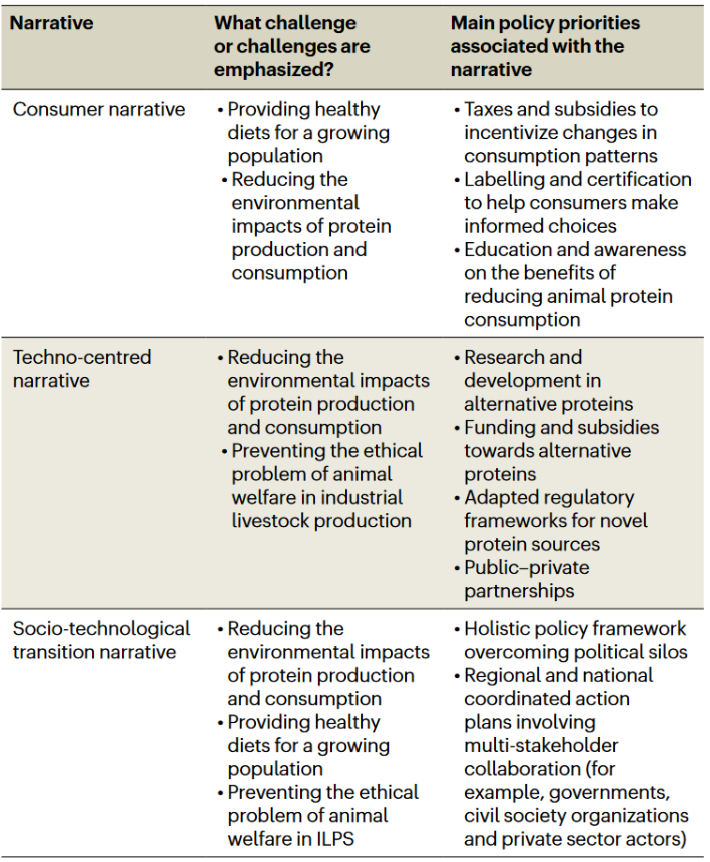
Researchers identify, via a systematic review process, three major narratives that have emerged around the ‘protein transition’. These include the consumer narrative, the techno-centred narrative, and the socio-technological narrative. This paper explores the associated challenges and key policy priorities associated with each narrative.
Scientific evidence highlighting negative impacts arising from the overproduction and overconsumption of animal proteins is mounting. This article uses a systematic review approach to explore the ‘protein transition’ in high-income countries. The authors find there to be three major narratives in the literature; a consumer narrative, a techno-centred narrative, and a socio-technological narrative.
The article aims to identify definitions of the protein transition concept, key challenges that the protein transitions seek to address, and the narratives comprising the multitude of solutions to achieve the protein transitions. Within the literature selection criteria, the authors chose to focus on Organisation for Economic Co-operation and Development (OECD) countries to narrow the focus of the protein transition within high-income nations with relatively high levels of meat consumption. The authors note the protein transition concept is not suitable for regions where diets are nutritionally inadequate and are characterised by a lack of animal protein intake.
The article identifies three major protein transition narratives. Figure 1 demonstrates the three narratives and example action pathways to address challenges associated with environmental impacts, healthy diets, and industrial livestock production. The three narratives are: the consumer narrative, the techno-centred narrative and the socio-technological narrative.
Figure 1: Three protein transition narratives identified in this review with examples of associated action pathways to address challenges related to environmental impact, healthy diets, and industrial livestock production
The consumer narrative is centred on consumer-focused solutions. Its main goal is to shift dietary habits from animal proteins to alternative protein sources. It emphasises behavioural and cultural approaches. Figure two highlights key policy priorities suggested by the authors including taxes and subsidies which target consumption patterns, labelling and certification schemes, and education on the benefits of reducing animal protein consumption.
The techno-centred narrative focuses on solutions aimed at developing alternative proteins for food and feed through research, development, technology and infrastructure. In addition, technological innovations and infrastructure are seen as crucial means to advance the protein transition. The authors note these solutions are unlikely to be sufficient to achieve the transition by themselves. Figure two shows main policy priorities including research and development, funding and subsidies, and adapting regulatory frameworks associated with alternative proteins, as well as public-private partnerships.
The socio-technological narrative is anchored in a perspective of reconfiguring the whole-food protein regime, currently dominated by the animal protein sector. In this narrative, change must come not only from consumers but also from actors of the entire food system (for example, lobby groups, retailers, governments). The socio-technological narrative targets actions towards a holistic policy framework and regional and national coordinated action plans involving multi-stakeholder collaborations. Figure two highlights key policy priorities including holistic policy frameworks geared toward overcoming political silos, coordinated policy efforts across regional and national bodies and prioritisation of multi-stakeholder collaboration.

Figure 2: Table of three protein transition narratives and challenges emphasised by each and the associated policy priorities.
The authors conclude by stating that whilst the protein transition concept is increasingly used in the scientific literature, it lacks a consistent definition. This lack of clarity can pose potential issues as various perspectives on the protein transition emerge, reinforced by the diversity of actions and political priorities associated with the different narratives. The authors ask two guiding questions for future research. 1) do the proposed solutions address the challenges, and if so, how? And 2) to what extent do these solutions contribute to meeting the specified targets?
Abstract
The protein transition, aiming to rebalance protein intake between animal and alternative proteins, is gaining momentum in scientific and policy discussions on food system transformation. Here, using a systematic review approach, we identified 33 articles that address challenges in reducing the environmental impacts of protein production and consumption, providing healthy diets for a growing population and preventing adverse effects of industrial livestock production systems. We found unclear definitions of the protein transition, conflicting views on reduction or replacement of dietary protein and a lack of attention to systemic change by reducing protein to its macronutrient function. Three narratives were identified, namely, the consumer narrative focusing on consumption-based solutions targeting dietary changes; the techno-centred narrative developing new, more resource-efficient protein production systems; and the socio-technological narrative that intends to transition the agri-food system from an animal-dominated regime to an alternative protein regime. We conclude that solutions should consider factors such as scale, initiating actors and expected impact to support complementary protein transition approaches.
Reference
Duluins, O., Baret, P.V., 2024. A systematic review of the definitions, narratives and paths forwards for a protein transition in high-income countries. Nature Food 1–9.
See other publications exploring food challenges framings Three perspectives on sustainable food security and Food sustainability: problems, perspectives and solutions
Read the full article here. See our discussion on the protein transition in The Politics of Disgust: What future for protein? and Meat, metrics and mindsets: Exploring debates on the role of livestock and alternatives in diets and farming. Also, for a look at different protein transition framings see our report Gut feelings and possible tomorrows: (where) does animal farming fit?







Post a new comment »